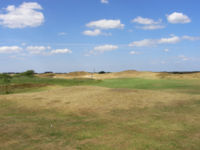Fanø Golf Links
| Fanø Golf Links | |
|---|---|
 View over the area from the 9th tee |
|
| Place data | |
| Coordinates: | 55 ° 26 '18 " N , 8 ° 21' 56" E |
| Playable since: | 1901 |
| Architect: | Robert Dunlop |
| Extensions: | |
| Par: | 70 |
| Length: | 5,080 meters |
| CR / Slope : |
68.7 / 119 |
| Character: | Left |
The Fanø Golf Links is the oldest existing golf course in Denmark and is located on the island of Fanoe . It is the only links course in Denmark.
history
Although the Københavns Golf Klub was founded in 1898 and the first holes were laid there a year later, Fanø still has Denmark's oldest golf course, as the original Copenhagen courses have not been preserved. The first 9 holes of the Fanø Golf Links were laid in 1901 by the Scottish Robert Dunlop (* 1877). He was actually a professional golfer in Prestwick , Scotland and later immigrated to the USA, where he settled in the Chicago area. Robert Dunlop is not aware of any other activities in the field of golf architecture, so it is also conceivable that he was primarily hired as a kind of figurehead .
The construction of the golf course is, as in many places in Europe of the beginning tourism, to be seen in connection with the expansion of Fanø Vesterhavsbad to an international holiday resort. In this respect, an effective promotional opening event can be assumed, which is probably identical to an open golf tournament that took place on August 10, 1901 in Fanø and was won by Robert Dunlop. A medal in the possession of his descendants bears these key data, as well as the name of the tournament: "International Golf Championship of Denmark". The same name as well as the year 1901 and the place Fanø can be found on a trophy that is on display in the clubhouse of the Golf Club zur Vahr in Bremen . It was won by an Agnes Boecker von Kapff (1880-1970), who is known to be the first German female winner of an international golf tournament.
This "International Golf Championship of Denmark" from 1901 is of particular importance because it is the first open golf tournament that can be verified on the European continent.
In 1930 the golf course was expanded to 18 holes, but there were always undocumented changes, so that today it is not clear what exactly has been preserved from the original layout. Experts consider greens 16 and 17 to be the oldest on the course.
The Fanø Vesterhavsbads Golf Club was only founded in 1948 and initially had mainly summer guests as members. Today the number of members is around 2000, but many of them are outside of the city, so that the place can also be used by guests. Fanø Ugerne (Fanø Golf Weeks) takes place every year in the last two weeks of July, a series of tournaments designed to keep the tradition of golf on Fanø alive.
Golf aspects
character
The Fanø Golf Links are rightly named, they are reminiscent of the traditional links that are only found in remote areas today, even in Scotland. The lanes are short and are completely left to the elements in terms of maintenance, teeing off from mats and the small, hard greens are often hidden and not very susceptible to the classic, high approach shot.
Due to its unique location in the dunes, not far from one of Denmark's largest beaches, the course is subject to extremely strict environmental regulations. No bunkers may be created, irrigation and fertilization are not permitted. Most of the conceivable redesigns, such as rerouting the railways according to modern criteria or even expanding them to include the dunes already on the site, seem to be ruled out for all time. Some particularly lush areas are marked out as water hazards. Due to these requirements, Fanø Golf Links were able to largely retain their original character.
The routing simply follows the dunes, the ball is played where no heather or beach grass grows and otherwise the wind provides the sporting challenge. Occasionally the fairways are difficult to see, so that without knowledge of the course, even after successful strokes, quite unfavorable positions can arise. Certain imponderables, for example in the form of rabbit holes, can also come into play on the intended line. Due to the relatively short lanes, the course can still be tackled by less experienced golfers.
Special landmarks
An unusually large number of greens must be played blindly, so that players putting there are often not visible. To ensure their safety, old railway signals were installed on the greens, which are operated by cords. If a flight arrives there, a player puts the bar on horizontal and thus signals that the green is occupied. When leaving the green, the bar is placed vertically again and the following group can play.




